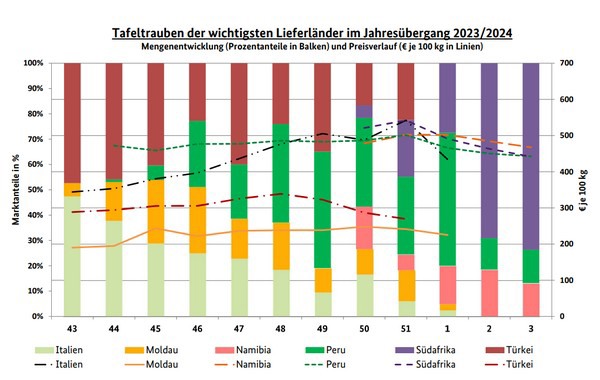South African table grapes seemed to dominate the market; imports from Namibia and Peru only played a supplementary role. Chilean batches, pre-packaged in bowls, were usually sent directly to retailers. Deliveries expanded overall. According to the BLE, the demand did not always keep up. Low temperatures and snowfall significantly limited the sales possibilities.

Furthermore, quality problems also caused noticeable purchasing restraint. Moreover, for this reason, a rather wide price range was established in some places. Accordingly, pricing was often very inconsistent. On the one hand, the prices of goods from different sources, especially the dominant light seedless from South Africa, were trending downwards, on the other hand, price increases were particularly noticeable in Cologne and Munich.
Apples
The range of goods had not changed significantly. Domestic offers still dominated over Italian and French ones. Shipments from the Netherlands and Belgium completed the assortment. Prices developed differently: rising prices were just as noticeable as discounts.
Pears
Turkish Santa Maria and Italian Abate Fetel formed the basis of the assortment. The Netherlands mainly provided Conference and Xenia. Turkish Deveci, Italian Santa Maria, and Belgian Conference supplemented the scene. Xenia, Alexander Lucas, and Conference mainly came from domestic sources.
Oranges
Spanish Blond oranges were apparently predominant: In addition to Navelina, Navel was delivered increasingly. Turkish Washington Navel played a subordinate role, but left something to be desired in terms of their taste in some places. Only small quantities came from Egypt.
Small citrus fruits
Spanish, Israeli, and Turkish mandarins were becoming increasingly important, while Clementines from Spain, Morocco, and Italy were losing relevance; their sales period already ended in Hamburg. Availability had expanded and was sufficient to cover the demand.
Lemons
Spanish Primofiori predominated. Turkish Enterdonato and Meyer lemons were increasingly joined by Lamas, which quickly attracted attention in Berlin thanks to their thin skin and not too sour aroma. Imports from Egypt increased: 15 kg of lemons cost between 18 and 18.50 € in Frankfurt.
Bananas
Primary brands became more expensive in several markets, while the prices of the secondary and tertiary brands often stagnated at their previous levels. In Frankfurt, secondary brands were in the spotlight, tertiary brands were very rare there.
Cauliflower
Italian deliveries predominated. Spanish and French shipments followed in terms of importance. The range of goods was supplemented by Belgian, Turkish, and Dutch goods. In Frankfurt, the French products became so expensive due to the procurement costs that some traders refrained from them.
Lettuce
As far as iceberg lettuce went, Spanish goods could be accessed almost exclusively. Only in Berlin did imports from Egypt supplement the range. Butterhead lettuce came in from Belgium, Italy, and subsequently from France. Mixed salads came from France and Italy.
Cucumbers
Spanish cucumbers dominated. In addition, Belgian, Dutch, Greek, and Moroccan parties could be accessed. Their availability had expanded; the start of the Dutch season brought some volumes in. This immediately affected the prices of the Spanish competition.
Tomatoes
Vine tomatoes mainly came from Spain and Turkey, and subsequently from Belgium and the Netherlands. Round tomatoes were mainly supplied from Turkey, Morocco, and Spain. as far as beef tomatoes went, Spanish and Turkish batches could be accessed predominantly. Cherry tomatoes came in from Italy, Spain, and the Netherlands.
Vegetable peppers
The leading Spanish offers were flanked by Turkish imports. The availability was rather narrow. Nevertheless, prices often fell. In particular, yellow Spanish peppers, rated very highly in the previous week, became noticeably cheaper.
Source: BLE
